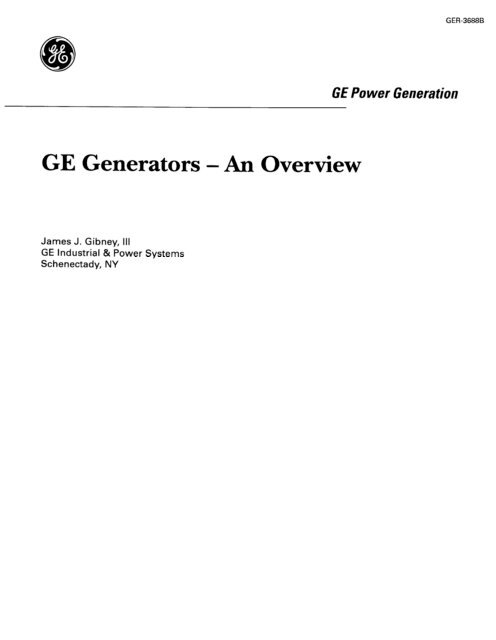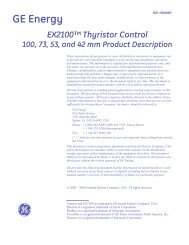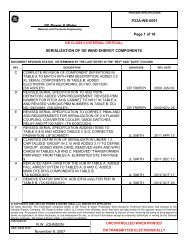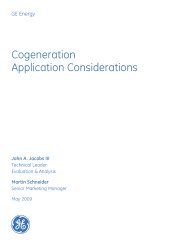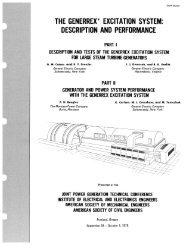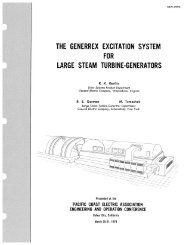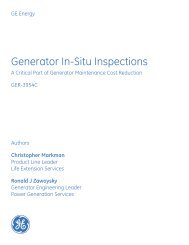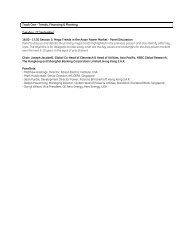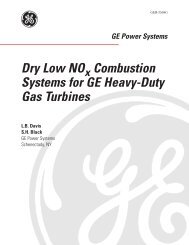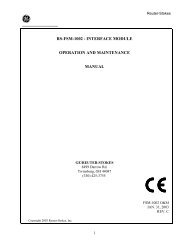GER3688B - GE Generators - An Overview - GE Energy
GER3688B - GE Generators - An Overview - GE Energy
GER3688B - GE Generators - An Overview - GE Energy
You also want an ePaper? Increase the reach of your titles
YUMPU automatically turns print PDFs into web optimized ePapers that Google loves.
<strong>GE</strong> <strong>Generators</strong> - <strong>An</strong> <strong>Overview</strong><br />
James J. Gibney, III<br />
<strong>GE</strong> industrial & Power Systems<br />
Schenectady, NY<br />
<strong>GE</strong> Power Generation<br />
<strong>GE</strong>FL3688B
INTRODUCTION<br />
The history of <strong>GE</strong>’s design, manufacture and<br />
development of electric generators has been a<br />
long and varied one. Since the early 1900s more<br />
than 10,000 <strong>GE</strong> generators have been shipped<br />
and placed in service at utility companies and<br />
industrial plants, and as ship service units. The<br />
designs have evolved from slow-speed vertical-<br />
shaft units to high-speed horizontal shaft air-<br />
cooled units, through indirect hydrogencooled<br />
units to direct water-cooled units.<br />
During the 1950s through the mid-1970s much<br />
emphasis was placed on developing units to sup<br />
port the rapid growth in unit ratings, which<br />
increased from 100 MW to more than 1100 MW.<br />
It was during this time frame that such innovative<br />
design features as direct water-cooled armature<br />
windings, gap-pickup rotor winding cooling,<br />
Micapal II TM stator insulation, Class F rotor and<br />
stator insulation, advanced TetralocTM stator end-<br />
winding support systems, and the side ripple-<br />
spring armature bar slot support structure were<br />
developed.<br />
In the early 1960s packaged gas-turbinedriven<br />
generators were introduced. These applications<br />
were characterized by the ambient-temperature-<br />
following nature of the gas turbine output and the<br />
ability of the gas turbine to provide peaking capa-<br />
bility for short periods. Generator designs were<br />
developed which were tailored to gas turbine<br />
applications. As new gas turbines were intro-<br />
duced, or as older designs were uprated, genera-<br />
tor designs were introduced to match the new gas<br />
turbine ratings.<br />
Over the course of the past decade, the empha-<br />
sis in new electric power generation installations<br />
has swung away from large units delivering major<br />
blocks of power to smaller units operated not only<br />
by utilities, but by cogenerators or other smaller<br />
independent power production companies. In<br />
response to this change, <strong>GE</strong> is placing a major<br />
emphasis on the design and development of gen-<br />
erators suited to these applications.<br />
Excluding marine service applications, <strong>GE</strong> cur-<br />
rently has more than 6400 generators in service<br />
(Figure 1) . These generators can be placed in three<br />
major design classifications based on the cooling<br />
medium used: air, hydrogen and liquid cooled. This<br />
<strong>GE</strong> <strong>GE</strong>NERATORS - AN OVERVIEW<br />
J. J. Gibney, III<br />
<strong>GE</strong> Industrial & Power Systems<br />
Schenectady, NY<br />
NUMBER OF UNITS IN SERVICE -<br />
BY COOLING TYPE<br />
Air Cooled<br />
Liquid Hydrogen Open<br />
Cooled Cooled Ventilated TEWAC Total<br />
___ ~<br />
Steam<br />
rurbine-Driven 520 3,006 2 1,164 4,712<br />
Gas<br />
Turbine-Driven 1 214 1,340 151 1,706<br />
Totals 521 3,220 1,342 1,335 6,416<br />
Figure 1. <strong>GE</strong> generator experience<br />
paper will give an overview of each of these basic<br />
design classifications.<br />
DESIGN CONSIDERATIONS<br />
The design of synchronous generators is an<br />
optimization process. A generator design engi-<br />
neer’s challenge is to develop a final design that,<br />
as best as is practical, optimizes the overall size,<br />
efficiency, performance capabilities and electrical<br />
parameters, while maintaining mechanical, ther-<br />
mal and magnetic limits. In addition, the designer<br />
must be aware of the need to minimize the overall<br />
cost impact of the design.<br />
The development of modern analytical calcu-<br />
lation methods, including finiteelement analysis,<br />
supplemented with the use of improved materi-<br />
als, building upon component testing, has aided<br />
the generator designer in the pursuit of an opti-<br />
mal design.<br />
AIR-COOLED <strong>GE</strong>NERATORS<br />
Air-cooled generators are produced in two<br />
basic configurations: open ventilated (OV) and<br />
totallyenclosed water-to-air-cooled (TEWAC) . In<br />
the OV design, outside air is drawn directly from<br />
outside the unit through filters, passes through<br />
the generator and is discharged outside the gener-<br />
ator. In the TEWAC design, air is circulated within<br />
the generator passing through frame-mounted<br />
air-to-water heat exchangers.<br />
The recent emphasis in the marketplace on<br />
steam and gas turbinegenerators in the 20- to lOO-<br />
MVA size has provided <strong>GE</strong> with the impetus to<br />
<strong>GE</strong>R-3688B
<strong>GE</strong>R-3688B<br />
restructure its aircooled machines. A consequence<br />
of the historical development of the turbinegener-<br />
ator market was that two lines of generators<br />
evolved, one for steam turbine applications and the<br />
other for gas turbine applications, with little stan-<br />
dardization between the designs. As <strong>GE</strong> embarked<br />
on this design restructuring, it took the opportunity<br />
to look at other issues which <strong>GE</strong> judged were criti-<br />
cal to its ability to maintain leadership in the design<br />
and manufacture of this size generator. Among<br />
these issues were performance parameters, avail-<br />
ability of features, cycle time and cost effectiveness.<br />
MARKET NEEDS<br />
The basic design of a generator, while influ-<br />
enced primarily by material and electromagnetic<br />
properties, is also impacted by market require-<br />
ments. Hence, customer discussions as well as<br />
recent market trends are used in the development<br />
of a final generator design. Some of these include:<br />
winding temperature rise, industry standards, gen-<br />
erator ratings, etc.<br />
TEMPERATURE RISES<br />
In the early 1970s <strong>GE</strong> introduced insulation sys-<br />
tems capable of operating at class F temperatures<br />
(155 C, 311 F) for the life of the generator. This<br />
enabled a significant uprating of generator designs<br />
(about 10%) with a minimal increase in cost. To<br />
capitalize on this technical capability, <strong>GE</strong> designed<br />
generators with Class F insulation and Class F rises.<br />
Many such generators built by <strong>GE</strong> are in service<br />
and operating successfully at Class F temperatures.<br />
However, the trend in recent specifications has<br />
been toward Class F insulation systems operating at<br />
Class B temperatures. In order to be responsive to<br />
these requirements, the new designs will operate at<br />
Class B temperatures according to ANSI and IEC<br />
standards.<br />
<strong>GE</strong>NERATOR RATINGS<br />
In a rapidly developing technology, such as that<br />
of the combustion turbine, it is inevitable that the<br />
output of a given gas turbine frame size will be<br />
increased from time to time. This has required<br />
redesign of the generator to keep pace with the<br />
rise in turbine output. The ratings of the genera-<br />
tors designed to match the gas turbine frame sizes<br />
have been set so that the generator will meet or<br />
exceed the gas turbine capability over the full<br />
operating temperature range, taking into account<br />
the expected turbine upratings duriiig the life-<br />
time of the design.<br />
<strong>An</strong>other important consideratioil that affects<br />
the generator rating which must be taken into<br />
2<br />
account is the use of steam and water injection for<br />
NO, control. The output of the gas turbine can<br />
increase by 5% or more above its dry IS0 rating,<br />
depending on the level of steam or water injection<br />
required to meet the emission requirements. <strong>An</strong><br />
approach that results in the generator having suf-<br />
ficient capacity to match the gas turbine at the<br />
required NO, requirements has been factored<br />
into the generator rating.<br />
STANDARDS<br />
All new designs will meet the requirements of<br />
the applicable ANSI and IEC standards, as did the<br />
older designs.<br />
RELIABILITY<br />
Particular attention has been paid to known<br />
problem areas based on inservice generator experi-<br />
ence. The new designs strive for a high level of relia-<br />
bility and availability through attention to detail<br />
design and to the problems that have caused down-<br />
time on older designs. In addition, the reliability of<br />
the product will improve through design simplifica-<br />
tion and standardization, discussed below.<br />
PRODUCT<br />
STANDARDIZATION<br />
Standardization of the product line has signifi-<br />
cant benefits both to the user and to the manufac-<br />
turer. From the user’s viewpoint, the standardiza-<br />
tion of the product line translates into a simpler<br />
machine with fewer unique parts, easier spare<br />
parts access and the reliability benefit of a larger<br />
fleet of identical machines, with the rapid identifi-<br />
cation of any performance problems that this<br />
brings. The benefits to the manufacturer are that,<br />
with fewer unique parts to track and check, fewer<br />
different assemblies to build and fewer drawings<br />
to keep up to date, the job of building a highqual-<br />
ity machine becomes simpler.<br />
Standardization is being implemented at three<br />
levels. At the highest level, the number of differ-<br />
ent designs can be reduced by careful selection of<br />
generator ratings and the use of common designs<br />
for gas and steam turbines. At the time the<br />
redesign project was begun, there were 17 unique<br />
air-cooled generator designs between 12 MVA and<br />
100 MVA. With careful choice this has been<br />
reduced to six basic electromagnetic designs.<br />
The second level of standardization is illustrat-<br />
ed in Figure 2. This shows the high level of stan-<br />
dardization achieved in covering the basic config-<br />
urations of the generator for the Frame 6 gas<br />
turbine (designated 6A3), 50 Hz or 60 Hz, open
Design Option<br />
6A3<br />
6OHz 5oHz 6OHZ<br />
Generator Component TEWAC ov TEWAC ov<br />
BSBSBSBS<br />
Frame.. ............................................... . .. . ,<br />
Core.. ............................................... . . .. . . . .<br />
Base .................................................<br />
. . . . l . l<br />
Slator Bar 50 Hz.. ............................... . .<br />
Stator Bar 60 Hz ............................... l . t f<br />
Brushless Exe .................................... * .<br />
Static Ext.. ........................................ * 1 .<br />
ov Roof.. .......................................... t * l<br />
TRNAC Roof.. ......................................<br />
Rotor Forging.. .................................. - ... . . l<br />
Rotor Copper ................................... l . l .....<br />
Rotor Edg. 60 Hz ............................. . l ..<br />
Rotor Wdg. 60 Hz.. .............................<br />
, .<br />
Rotor Slot Width ............................... . . . ....<br />
Rotor Slot Depth 50 Hz .................... t t l .<br />
Rotor Slot Depth 60 Hz .................... l * t .<br />
* .%me Canp~nent Applied to Deoign Option<br />
ventilated (OV) or totally enclosed (TEWAC) , and<br />
brushless or static excitation. For example, the sta-<br />
tor frame, core and base, and the rotor forging<br />
and rotor copper cross section are identical for<br />
any combination of these features. The only dif-<br />
ference between the 50-Hz stator and the 60-Hz<br />
stator is the different stator bar. Everything else is<br />
the same. This component standardization can be<br />
extended to other ratings when the same compo<br />
nent is used for two different machines. For exam-<br />
ple, the generator base is the same for the Frame<br />
5 generator as it is for the Frame 6 generator. In<br />
B - Brushless Excitation<br />
S - Static Excitation<br />
Figure 2. Generator standardization<br />
<strong>GE</strong>R-3688B<br />
GT164SOA<br />
addition, while the gas turbines are the primary<br />
application of the new air-cooled generators, they<br />
can and have been applied with steam turbine<br />
drives as well (Figure 3).<br />
The most detailed level of standardization is<br />
with hardware such as fasteners and small compo<br />
nents. A carefully constructed list of preferred<br />
hardware has been developed and the number of<br />
different nuts, bolts and similar items has been<br />
drastically reduced.<br />
The impact of standardization is illustrated in<br />
Figure 4, which shows the reduction in the num-<br />
ber of parts and drawings required to build a sin-<br />
I-<br />
REL. # OF<br />
PARTS<br />
REL. # OF<br />
DRAWINGS<br />
OLD DESIGN NEW DESIGN<br />
1.0 0.6<br />
1.0 0.7<br />
GT19263 GT1649’<br />
Figure 3. Air-cooled steam turbine generator Figure 4. Impact of standardization<br />
3<br />
,
<strong>GE</strong>R-3688B<br />
gle new design as compared to its predecessor.<br />
When these gains are compounded by the<br />
reduced number of unique designs, there is a pro<br />
found effect on the productivity and quality of the<br />
manufacturing operation.<br />
One of the potential adverse effects of stan-<br />
dardization can be a loss of flexibility to meet an<br />
individual customer’s needs. This has been<br />
addressed first by building into the design those<br />
features that are frequently specified. <strong>An</strong> example<br />
is the use of stainless steel oil feed piping. This fea-<br />
ture is not requested by every customer, but it is<br />
asked for often enough such that it is easier to<br />
build every unit with the stainless steel piping. The<br />
second way in which individual needs have been<br />
met is through “standard options.” These are pre-<br />
engineered options commonly requested for<br />
which drawings have been prepared ahead of<br />
time.<br />
These options can be readily incorporated in<br />
the machine, within normal material procure-<br />
ment and manufacturing cycles. <strong>An</strong> additional<br />
group of options is available that have not been<br />
pre-engineered due to the low frequency of<br />
request. These are available but with longer lead<br />
times since the necessary engineering work must<br />
be accommodated.<br />
DESIGN AND<br />
CONSTRUCTION FEATURES<br />
The design teams involved were organized with<br />
representation from all the major business func-<br />
tions, and members of the design teams visited<br />
some representative customers to better under-<br />
stand user needs. In this way, the technical<br />
requirements of the designs were influenced by<br />
the needs of all the functions involved in the<br />
design, manufacture, marketing and maintenance<br />
of the generator. Features were incorporated into<br />
the design specifically to aid producibility. Visits to<br />
and discussions with potential vendors influenced<br />
the design of components both for improved per-<br />
formance and to suit vendors’ capabilities. Careful<br />
cost comparisons were made of alternative design<br />
approaches to ensure that the final configuration<br />
was cost effective.<br />
ELECTROMAGNETIC DESIGN<br />
To achieve the reliability objectives of the pro<br />
ject, no new electromagnetic design limits have<br />
been used. The designs are based on proven tech-<br />
nology used in generators already in service.<br />
Where appropriate, the technology used in larger<br />
units has been drawn upon to improve the<br />
designs of these machines. In reaching the final<br />
4<br />
configuration, a large range of design alternates<br />
was considered, and the final choice of design<br />
reflects the optimization of the types of considera-<br />
tion described herein.<br />
STATOR DESIGN<br />
The stator frame is divided onto an inner and an<br />
outer section, both of which mount on a single<br />
base fabrication. The inrrer frame is a very simple<br />
structure designed to support the stator core and<br />
winding while providing some guidance to the air<br />
flow in the machine. The stator core, made from<br />
grainoriented silicon steel for low loss and high<br />
permeability, is mounted rigidly in the inrrer frame.<br />
Isolation of the core vibration from the remainder<br />
of the structure is accomplished through the use of<br />
flexible pads between the feet on the inner frame<br />
and the base structure. The combined core and<br />
inner frame are designed to have a four-nodal natu-<br />
ral frequency well removed from 100 Hz or 120 Hz,<br />
and tests on the assembled inner frame confirmed<br />
the predicted natural frequencies.<br />
The outer frame is a simple fabricated enclo-<br />
sure, which supports either the air inlets and<br />
silencers if the unit is open ventilated (Figure 5)<br />
or the roof and cooler enclosure if the unit is<br />
totally enclosed, water-to-air-cooled. The outer<br />
frame further acts as an air guide to complete the<br />
ventilation paths and as a soundproof enclosure<br />
to keep noise levels low. Since the rotor is pedestal<br />
mounted, the end shields are very simple struc-<br />
tures. As with the inner frame, the outer frame<br />
was designed to be free of resonances below 80<br />
Hz, and again, tests of the completed structure<br />
confirmed the design analysis.<br />
The entire generator is mounted on a single<br />
fabricated base, which supports the pedestals, the<br />
inrrer and outer frames, and the brush rigging or<br />
the exciter. The base contains piping for oil sup<br />
plies, conduit for wiring and a number of compo<br />
nents associated with the main leads, such as light-<br />
ning arresters and surge capacitors. The structural<br />
vibration of the base was also confirmed by test to<br />
be well away from any frequency of concern.<br />
The stator winding is a conventional lapwound<br />
design. The insulating materials are those used<br />
since the early 1930s thus maintaining the proven<br />
reliability record. The materials are all designed<br />
and tested to provide reliable performance at<br />
Class F temperatures for the life of the machine.<br />
The stator bar copper is stranded and insulated<br />
with Class F materials and is Roebelled for mini-<br />
mum losses. The ground wall insulation is Micapal<br />
HT, a proven Class F system (Reference 1). This is<br />
a resin-rich tape system, with the volatiles removed<br />
under vacuum, which is then cured under pres-
J<strong>GE</strong>WERMRI<br />
,YR -:<br />
sIL:zlc4 I<br />
1 ; .:* I<br />
I I <strong>GE</strong>NERATOR AIR lNLET<br />
n<br />
FILLER BETWEEN<br />
CROSSOVERS<br />
VERTICAL<br />
SEPARATOR<br />
GLASS TAPE -E<br />
ARMOR I<br />
TOP RIPPLE j<br />
SPRING<br />
FILLER/ J<br />
<strong>GE</strong>NERAlOR CGMPIRTYEN,<br />
Figure 5. Generator packaging<br />
f<br />
STATOR SLOT ASSEMBLY<br />
/ INSULATED TOUGH PITCH<br />
COPPER WIRE WITH<br />
ROEBEL TRANSPOSITION<br />
EPOXY IMPREGNATED MICA<br />
A TAPE GROUND WALL<br />
\RTD OR<br />
FILLER<br />
SIDE RIPPLE<br />
SPRING<br />
\ WED<strong>GE</strong><br />
Figure 6. Stator slot section<br />
<strong>GE</strong>R-3688B<br />
GT18560<br />
GT18494A-1
<strong>GE</strong>R-3688B<br />
STATOR<br />
PUNCHINGS--,<br />
VENTILATION -<br />
DUCT<br />
BETWEEN BAR<br />
FILLER<br />
STAT01<br />
KEYBA.. \<br />
. . . . .<br />
WFDCXS .------<br />
sure to a solid, void-free structure. The exterior of<br />
the bar is taped with a conducting armor in the<br />
slot section, and a semi-conducting grading sys-<br />
tem is applied to the end arms. In this way the bar<br />
is fully protected from the effects of high electri-<br />
cal voltage gradients.<br />
The bars are secured in the slots (Figure 6)<br />
with fillers and top-ripple springs to restrain the<br />
bars radially, and with side-ripple springs to<br />
increase friction between the bar and the slot wall.<br />
The side-ripple springs are also conducting to<br />
ensure proper grounding of the bar surface.<br />
The end winding support system is the proven<br />
approach used on conventionally-cooled stators of<br />
all sizes built by <strong>GE</strong>. This system utilizes resin-<br />
impregnated glass roving ties (Figure 7).<br />
One design improvement made in response to<br />
problems experienced on some designs manufac-<br />
tured in the late 1970s is in the manner in which<br />
the series connection between top and bottom<br />
bars is made. Until recently, this was accomplished<br />
by brazing individual strands together and then<br />
solidifying the package with an epoxy. The<br />
improved system is to braze all the strands togeth-<br />
er in a solid block and then to braze top and bot-<br />
tom bars together with solid copper plates. This<br />
provides a solid electrical connection and a<br />
\<br />
! - STATOR<br />
FLAN<strong>GE</strong><br />
i<br />
r BINDING<br />
/ ’ BAND<br />
I<br />
;I SUPPORT<br />
_---- \<br />
-‘- \ \<br />
?<br />
‘- GLASS<br />
ROVING<br />
TIES<br />
\ \ M&END<br />
\<br />
BLOCK<br />
(FIN<strong>GE</strong>R)<br />
’ BINDING<br />
RAND<br />
Figure 7. Stator end winding section<br />
6<br />
TION<br />
GTlW!SA<br />
rugged mechanical joint.<br />
The complete end winding structure has been<br />
vibration tested to ensure freedom from critical<br />
resonances, and vibration levels measured during<br />
running tests were found to be low.<br />
ROTOR DESIGN<br />
The rotor (Figure 8) is a simple single-piece<br />
forging, pedestal mounted, with tilting-pad bear-<br />
ings for smooth operation. On smaller units, the<br />
rotor is sufficiently short that the second critical<br />
speed is above running speed, thus simplifying<br />
balance. The retaining ring is nonmagnetic 18 Cr<br />
18 Mn stainless steel for low losses and good stress-<br />
corrosion resistance. The rings are shrunk onto<br />
the rotor body, thus eliminating any risk of top<br />
turn breakage. The retaining ring is secured to<br />
the rotor body with a snap ring, a design which<br />
minimizes the stresses in the tip of the retaining<br />
ring.<br />
Radial-flow fans are mounted on the centering<br />
ring at each end of the rotor. The fan is a high-<br />
efficiency design, and when tested prior to use in<br />
the generator proved to have satisfactory margins<br />
compared to the design requirements. The fans<br />
provide cooling air for the stator winding and
Fan<br />
/<br />
:YIR OUTLE 1<br />
s,,k%ls~<br />
‘I s =--= 1<br />
I<br />
Ring<br />
4 I<br />
tie --.... ’<br />
Figure 8. Generator field<br />
1<br />
AIR FILTER<br />
Fan<br />
$r II -f-- J -J-<br />
I<br />
I<br />
* SILENCEAS<br />
INLET<br />
I j <strong>GE</strong>NERmJR 1<br />
/ A,R INLET<br />
‘i -- -- ..--<br />
I i '/%ki I 'I Lg.& t BEARING<br />
t .--<br />
- -.<br />
I- DRIVE ’ -_, ‘;;ib- l-y;dA<br />
-*<br />
7;:<br />
<strong>GE</strong>AR i,r: i+. _- 1 IA<br />
“: i I;<br />
.I 1,<br />
.<br />
t<br />
1. -- ;;;T-g*1,<br />
imm, ‘-‘I ,: 1 ’<br />
core. The rotor winding, which is a directlycooled<br />
radial flow design, is self-pumping and does not<br />
rely on the fan for air flow. The overall ventilation<br />
pattern is shown in Figure 9.<br />
The rotor winding fits in a rectangular slot<br />
(Figure 10) and is retained by a full-length wedge<br />
on the shorter machines. Where cross slots are<br />
I p!JJ--~7+sJ,,~<br />
H I-- ‘:Ag<br />
rlj’ .-, _IJ’<br />
TR;:;aEFls ^:;g$g=<br />
K.‘&-;/y ; +,I,-’<br />
^.._^r..l SW& ! &mms<br />
Figure 9. Generator cross section and ventilation paths<br />
7<br />
GTlWX<br />
GT18561<br />
required on longer rotors, several wedges are used<br />
in each slot. The rotor slot insulation, turn insula-<br />
tion and other materials in contact with the wind-<br />
ing are full Class F materials and have proven reli-<br />
ability through use on other generator designs.
<strong>GE</strong>R-3688B<br />
COll Wedge<br />
creepage BlWk<br />
Field COll<br />
Turn l”S”latlOn<br />
slot Armor<br />
- Sub sot<br />
Channel<br />
Figure 10. Section through coil slot<br />
PACKAGING DESIGN<br />
GI1lU!M<br />
The objective in the packaging design has been<br />
to reduce the number of sections (Figure 5) to<br />
simplify the structure and to improve the piping<br />
and wiring design for fewest parts and ease of<br />
assembly. The lesser number of package sections<br />
leads to a stronger structure, but, more important-<br />
ly, results in fewer feet of joint through which<br />
unfiltered air can leak, thus aiding cleanliness in<br />
the generator. Depending on the design, a num-<br />
ber of components have been relocated from the<br />
auxiliary cubicle into the base, simplifjring the<br />
design of the auxiliary cubicle. Components in the<br />
base are low-maintenance items, and are accessible<br />
through covers in the collector compartment.<br />
A great deal of attention has been paid to cus-<br />
tomer requirements in this area, as the prefer-<br />
ences of individual users frequently require pack-<br />
aging changes. Ease of addition or removal of<br />
features and hardware is critical to meeting these<br />
needs within the normal cycle times.<br />
TESTING<br />
Extensive prototype testing of each of the new<br />
designs, both in the factory and under load at a<br />
customer’s site, has proven that the designs meet<br />
Electrical Testing<br />
l Excitation Requirements<br />
l Short Circuit Ratio<br />
l Temperatures<br />
Mechanical Testing<br />
l Rotor Vibration<br />
l Stator Frame Vibration<br />
l Noise<br />
l Stator Winding Vibration<br />
l Ventilation<br />
GT22940<br />
Figure 11. Factory and load test objectives<br />
Journal Probe<br />
Location<br />
and Orientation<br />
Turbine End Horizontal<br />
Turbine End Vertical<br />
Collector End Horizontal<br />
Collector End Vertical<br />
Measured Vibration<br />
Mils Peak-to-Peak (MM)<br />
Broadband Filtered - l/Rev<br />
0.90 (.023) 0.37 (.009)<br />
1.00 (.025) 0.46 (.012)<br />
0.60 (.013) 0.19 (.005)<br />
0.50 (.013) 0.23 (.006)<br />
Figure 12.6A3 journal vibration maximum val-<br />
ues observed for all speed and operat-<br />
ing conditions<br />
all the expected performance requirements<br />
throughout the load range. Some of the key test<br />
objectives are listed in Figure 11.<br />
Loss measurements confirmed the prediction<br />
of generator efficiency at the generator rated out-<br />
put, and heat runs both in the factory and under<br />
load confirmed that the generator would meet<br />
both NASI and IEC standards for Class B tempera-<br />
ture rise.<br />
At the design stage, a great deal of attention<br />
was focused on achieving a smooth running rotor.<br />
Figure 12 shows the levels measured on a 6A3 at<br />
the site. These levels are significantly lower than<br />
those required by API, and also are much lower<br />
than those in a recently issued draft international<br />
standard (7919/3). The API requirements for sep<br />
aration margins of rotor lateral critical speeds<br />
from operating speeds were also fully met.<br />
A noise survey was conducted during startup of<br />
the first 6A3, using the sound intensity method<br />
which compensates for ambient noise effects. The<br />
average generator near-field sound pressure was<br />
determined from the measurements to be 85.7<br />
dBA, which is very satisfactory, and compares<br />
favorably with the design target of 85 dBA.<br />
CURRENT STATUS<br />
Three new machines have been designed to<br />
match the <strong>GE</strong> Frame 5,6 and ‘7 gas turbines. More<br />
than 130 generators of these new designs have<br />
been shipped through the end of 1992, with<br />
approximately one-half in service.<br />
The air-cooled generator product line is contin-<br />
uing to evolve. The generator that is being<br />
applied with the LM6000 aeroderivative gas tur-<br />
bine (Figure 13) was tested and shipped in 1992.<br />
Its basic configuration is open ventilated (with a<br />
TEWAC option), brushless exciter, pedestal-<br />
mounted bearings, on a “single-lift” base, rated 60
FluId<br />
Figure 13. LM6000<br />
Relative<br />
Spectfic<br />
HEat<br />
Relative<br />
Denstty<br />
Relative<br />
Practical<br />
Vol Flow<br />
RDC26475-2 GO2A-00.044<br />
Figure 15. Hydrogen-cooled generator<br />
Approx.<br />
Rel Heat<br />
Removal<br />
Abihty<br />
1 1.0 1 1.0 1 10 I 1.0 )<br />
Hydrogen 30 pslg (2.07 bar) 14.36 0.21 10 3.0<br />
Hydrogen 45 psig<br />
(3.10 bar) 14.36 0.26 IO 4.0<br />
Water 4.16 1000.0 0 012 50.0<br />
GT21022A<br />
Figure 14. Air, hydrogen, water heat removal<br />
comparison<br />
MVA at 0.8 pf. In 1993, a 160 MVA, 50-Hz air-<br />
cooled generator, to be used primarily with the<br />
frame 9E gas turbine, will be tested as well.<br />
HYDRO<strong>GE</strong>N-COOLED<br />
<strong>GE</strong>NERATORS<br />
As the rating of steam turbines rose in the<br />
1930-1950 time frame, it became clear that in<br />
order to keep the size, weight, ability to ship and<br />
cost of a generator within reason, a more optimal<br />
cooling medium needed to be used. Hence the<br />
introduction of hydrogen.<br />
How well the armature winding of a generator<br />
is cooled has a significant influence on the overall<br />
size of a synchronous generator. The cooling of<br />
the armature winding is dependent on a number<br />
of factors: cooling medium (air, hydrogen, water) ;<br />
insulation thickness; and overall electrical losses<br />
(12R + load loss). As Figure 14 shows, relative heat<br />
removal capability improves from air to hydrogen,<br />
with increased hydrogen pressure, and even more<br />
significant with the use of water cooling.<br />
Conventional hydrogen cooling can be utilized on<br />
generators rated approximately 300 MVA and<br />
9<br />
Figure 16.7F generator<br />
RDC26126.21-3<br />
below, while direct water cooling of armature<br />
windings is applied to units above 250 MVA. This<br />
division results from design optimization. While it<br />
is possible to apply water cooling on machines<br />
rated below 250 MVA, the cost/performance ben-<br />
efit suffers. Water cooling adds manufacturing<br />
complexity, as well as requires the need for an<br />
auxiliary water cooling and deionizing skid, plus<br />
associated piping, control and protection features.<br />
At higher ratings, the cost of this complexity is off-<br />
set by the advantage of producing a generator of<br />
significantly smaller size than a comparable con-<br />
ventionallycooled generator.<br />
Hydrogen-cooled generator construction<br />
(Figure 15)) except for the frame, is very similar<br />
to that of air-cooled generators. The stator slot<br />
and end winding support designs are essentially<br />
like those shown in Figures 6 and ‘7. Most designs<br />
use direct radial flow cooling similar to that<br />
shown in Figure 10. The stator frame, on the<br />
other hand, because of the need to contain 30<br />
psig (2.07 bar) to 45 psig (3.10 bar) hydrogen,<br />
uses thick plate cylindrical construction. End<br />
shields are appropriately more rugged, and con-<br />
tain a hydrogen seal system to minimize leakage.<br />
Conventional hydrogen cooling, while available<br />
<strong>GE</strong>R-3688B
<strong>GE</strong>R-3688B<br />
-<br />
G02A-00-043<br />
/<br />
Figure 17. Water-cooled generator F @we 19. Water-cooled stator winding<br />
.-”<br />
arrangement<br />
GO4A-00-019<br />
Figure 18. Hollow copper strand construction<br />
for generators rated below 100 MVA, is most<br />
often applied to steam-turbinedriven units above<br />
100 MVA, as well as with the frame 9 and 7F<br />
(Figure 16) and frame 7FA and 9F gas turbines.<br />
HYDRO<strong>GE</strong>N/WATER-COOLED<br />
<strong>GE</strong>NERATORS<br />
Even more compact generator designs are<br />
achievable through the use of direct water cooling<br />
of the generator armature winding (Figure 17).<br />
These designs employ hollow copper strands<br />
(Figure 18) through which deionized water flows.<br />
The cooling water is supplied via a closed-loop<br />
auxiliary-base-mounted skid. The cool water<br />
enters the winding through a distribution header<br />
on the connection end of the generator and the<br />
warm water is discharged in a similar manrrer on<br />
the turbine end of the generator (Figure 19).<br />
The armature voltage and current of hydro-<br />
gen/watercooled generators are significantly high-<br />
er than those of air- or hydrogencooled units. As a<br />
result, the insulation voltage stress and forces on<br />
the armature windings can be several orders of<br />
magnitude larger than those experienced on lower-<br />
10<br />
Xela~rvai<br />
?OO<br />
systarri<br />
Faults<br />
FGiZO ioao Cycrlng<br />
f-1 hom?ai Expanslan)<br />
1 -<br />
Normar<br />
Fiunnmg<br />
FBC%S<br />
i<br />
L-. ---L ..-.--.-L-.-L-<br />
7 102 d 4 1010 30’2<br />
Total ~*~~~ of Cycles<br />
w a .3t?-bar 4ime Span<br />
Figure 20. Cyclic duty on stator winding in<br />
30 years<br />
POP35782<br />
GT21019<br />
rated units. These present unique design require-<br />
ments must be addressed if high reliability and<br />
long life of the equipment is to be maintained.<br />
Insulation<br />
The stator insulation material used in modern<br />
<strong>GE</strong> water-cooled generators consists of an epoxy-<br />
mica-based system called Micapal. Micapal I was<br />
introduced in 1954, partially as a solution to tape<br />
migration and girth cracking problems associated<br />
with the then almost universally applied asphalt-<br />
insulation-based system.<br />
In 1975, an improved epoxy-mica system was<br />
introduced (Micapal II). This all-mica paper insu-<br />
lation has improved mechanical toughness (15%)<br />
and voltage endurance (12%). While these prop<br />
erties were developed to meet the requirements<br />
of very large ratings, the application of Micapal II<br />
on small and midsize units permits further opti-<br />
mization opportunities. Micapal II has excellent<br />
thermal cycling capability, and is particularly suit-<br />
ed for the daily start/stop duty required of many<br />
units today.
GT17109<br />
Figure 2 1. Armature bar restraint in stator slot<br />
Forces on Stator Winding-s<br />
There are two sources of force on the stator<br />
windings: high-level, short-duration transient<br />
forces due to system or misoperation faults, as well<br />
as those that result from normal load currents<br />
and load cycling.<br />
Figure 20 charts frequency of occurrence against<br />
relative magnitude for these forces. Each type of<br />
force requires careful consideration during the<br />
design process. High-level fault currents can cause<br />
very high forces, which will cause major winding<br />
damage if not suitably restrained. Load cycling, and<br />
the thermal expansion which accompanies it, is a<br />
daily event that causes expansion and contraction<br />
of the entire windings. If components are not suit-<br />
ably designed, or if windings are unduly restrained<br />
in the axial direction, lowcycle fatigue damage may<br />
occur. Finally, the electromagnetic forces at twice<br />
system frequency due to normal load currents may<br />
cause fretting or highcycle fatigue of components,<br />
particularly if a component has a mechanical reso<br />
GT17110<br />
Figure 22. Stator and winding support cross<br />
section<br />
11<br />
nance close to double frequency.<br />
These forces require the design engineer to<br />
closely examine the detail design of the endwind-<br />
ing and stator slot sections.<br />
Stator Slot Support System<br />
The key elements of the stator-slot support<br />
system design (Figure 21) are:<br />
Careful assembly of the stator core to ensure<br />
a uniform slot dimension and avoid “high<br />
areas.”<br />
Use of side ripple springs full length along<br />
each bar to ground the bar armor to the slot<br />
and provide permanent friction damping<br />
against tangential and radial motion.<br />
A top-of-slot, radial force wedge designed to<br />
securely hold the armature bars down to the<br />
bottom of the slot, preventing potential<br />
destructive bar motion.<br />
Freedom for axial movement to accommodate<br />
thermal expansion without component stress.<br />
Endwinding Support Structure<br />
Because the endwindings are suspended<br />
beyond the core, shortcircuit or faulty synchroniz-<br />
ing current forces are much more difficult to<br />
restrain than those in the stator slots. In addition,<br />
the structure itself has many more “degrees of free-<br />
dom” complicating the process of avoiding detri-<br />
mental resonant frequencies. As with the stator slot<br />
support system, the endwinding support system for<br />
a watercooled armature design is more complex<br />
than that for a conventionally-cooled winding.<br />
However, each of the support systems evolved from<br />
the same heritage, and both have provided<br />
extremely reliable service since their introduction.<br />
The advanced TetralocTM endwinding support<br />
system (Figure 22) is used on all water-cooled<br />
designs and features:<br />
l A support basket consisting of axial supports,<br />
supported from the stator flange, and contin-<br />
uous circumferential epoxy fiberglass rings.<br />
l Glass filament ties to secure the armature<br />
bars to the fiberglass rings.<br />
l Conformable, resin-impregnated, between-<br />
bar blocking to maintain bar spacing and<br />
provide mechanical support.<br />
Rotor Electrical Design<br />
The generator rotor contains the field windings<br />
that produce the magnetic flux, which, in turn,<br />
produces the stator current and voltage. Proper<br />
cooling of the field winding is another challenge<br />
<strong>GE</strong>R-3688B
<strong>GE</strong>R-3688B<br />
Creepage<br />
Block<br />
Copper<br />
Wmdmg<br />
Gas Flow<br />
GT21018<br />
Figure 23. Slot section of generator rotor wind-<br />
ing with radial-flow direct cooling<br />
that the generator designer must overcome.<br />
All hydrogen/water-cooled generators use<br />
direct conductor cooling of the rotor winding for<br />
heat removal. Smaller two-pole and all four-pole<br />
generators use the radial-flow design (Figure 23).<br />
At the end of the rotor body, hydrogen enters the<br />
windings through full-length subslots and is dis-<br />
charged along the length of the rotor body<br />
through radial slots, machined or punched, in the<br />
copper conductors. The hydrogen passes from<br />
the conductors through the creepage blocks and<br />
wedges to the “air gap,” where it is directed<br />
through the stator core to the hydrogen coolers.<br />
As generator ratings, and consequently rotor<br />
body length, increase even further, the gappickup<br />
diagonal-flow cooling method is employed<br />
(Figure 24). In this scheme, cold hydrogen is<br />
scooped up in the gas gap and driven diagonally<br />
through the rotor copper to directly remove the<br />
heat. At the bottom of the slot, the gas is turned<br />
and passes diagonally outward to the gas gap in a<br />
discharge stator core section. The stator core ven-<br />
I<br />
WARM GAS r OUTLET WED<strong>GE</strong><br />
OUT 8, COOL GAS IN<br />
\<br />
- SLOT INSULATION<br />
\<br />
‘. TURN INSULATION<br />
SUB-DIVIDED<br />
FIELD CONDUCTOR<br />
tilation is coordinated with the rotor-cooling gas<br />
flow, thus creating an in-and-out flow of hydrogen<br />
through the stator core, through the rotor, and<br />
returning to the hydrogen cooler through the<br />
core. This cooling method produces a tempera-<br />
ture profile, as shown in Figure 25, and results in a<br />
design which maintains the same average copper<br />
temperature, independent of rotor length.<br />
Rotor Mechanical Design<br />
There are significant challenges to be faced in<br />
producing an optimal generator rotor mechanical<br />
design. The following describes some of those<br />
challenges and features that have been incorpo-<br />
rated to meet those challenges.<br />
Retaining Rings<br />
The generator retaining rings, which support<br />
the rotor winding end turns against centrifugal<br />
force, are the most highly stressed components of<br />
the generator. On most designs they are shrunk on<br />
to the end of the generator body, as shown in<br />
Figure 26. Locking of the retaining ring to the gen-<br />
erator body is required to ensure the ring is not<br />
pushed off its fit surface due to the axial force gen-<br />
erated by thermal expansion of the field winding.<br />
Important design requirements of retaining<br />
rings are that they be tolerant to high stress levels,<br />
possess adequate low-cycle fatigue capability and<br />
have acceptable separating speeds. Therefore, a<br />
design is required where careful attention is paid<br />
to minimize stress concentrations. Large shrink-fit<br />
interferences are required to prevent separation<br />
under overspeed conditions, which result in rela-<br />
tively high stress levels at standstill. In most cases,<br />
INSULATING<br />
CREEPA<strong>GE</strong> BLOCK INLET WED<strong>GE</strong><br />
D COPPER CHANNEL<br />
\<br />
INSULATING CREEPA<strong>GE</strong> STRIP<br />
Figure 24. Air gap-pickup diagonal-flow rotor cooling scheme<br />
12<br />
GT17110A
I<br />
‘)“A c-,.“.(.*rln~<br />
CI I” ““I l”“C,“l<br />
Temperature Rise From Bottom<br />
OF OC<br />
140 60<br />
122 50<br />
104<br />
t<br />
40<br />
/’ -’<br />
-<br />
/ A<br />
II \I<br />
I<br />
T<br />
) Gas Temperature Rise<br />
,INi kt-ti<br />
Rotor<br />
Copper Temperature<br />
Figure 25. Diagonal-flow cooling field winding temperature profile<br />
Figm-e 26. Arrangement of locking key and<br />
shrink fit<br />
the ring material must be nonmagnetic to mini-<br />
mize the end leakage flux and reduce heating of<br />
the core end structure.<br />
For many years, nonmagnetic retaining rings<br />
have been made from an 18Mn-5Cr steel alloy.<br />
However, it was not until the mid-1970s that the<br />
susceptibility of 185 retaining rings to stress-corro<br />
sion cracking became known. As a result of coop-<br />
erative programs with retaining ring suppliers, a<br />
different alloy, 18Mn-18Cr (originally proposed by<br />
<strong>GE</strong>), was selected as a better retaining ring materi-<br />
al. This material has the required properties,<br />
including high resistance to stress-corrosion crack-<br />
ing in the types of environments of which rings<br />
may be exposed during the service life of the gen-<br />
erator. <strong>GE</strong> now supplies 18-l 8 retaining rings on<br />
its generators.<br />
13<br />
A<br />
Rotor Balance<br />
Baftle<br />
<strong>GE</strong>K3688B<br />
GTZlOZOA<br />
One of the most critical rotor manufacturing<br />
requirements, after all the parts are accurately<br />
machined and carefully assembled, is the final bal-<br />
ance operation. This ensures that the rotor vibra-<br />
tion will be within acceptable limits and that the<br />
rotor remains straight within very close tolerances<br />
at all running speeds up to and including the<br />
maximum specified overspeed.<br />
The design work initially includes the accurate<br />
calculation of all shaft stiffness and critical speeds. To<br />
correct for the double frequency vibrations which<br />
would otherwise occur, cross slots of appropriate<br />
depth and number are specified in the pole centers<br />
of most twopole rotors to equalize the bending stiff-<br />
ness between the direct and quadrature axes.<br />
Provisions are incorporated for making balance<br />
weight corrections. Each <strong>GE</strong> hydrogencooled gen-<br />
erator field is supported in its own pair of bearings.<br />
Balancing and overspeed testing are per-<br />
formed in <strong>GE</strong>’s factory balance facility. A high-<br />
speed multiplane modal balancing procedure is<br />
used. This procedure is done to ensure minimum<br />
vibration levels at every speed up to the maxi-<br />
mum specified overspeed.<br />
CONCLUSION<br />
While this paper has focused mainly on the<br />
“flange-to-flange” generator, the successful opera-<br />
tion of a steam or gas turbine generator involves<br />
other systems as well. Discussion of excitation,<br />
lube oil, hydrogen and stator cooling water sys-<br />
tems, as well as generator protection and opera-<br />
tion, can be found in other <strong>GE</strong> publications.
<strong>GE</strong>R-3688B<br />
The design of modern generators, whether<br />
they are air, hydrogen or hydrogen/water-cooled,<br />
requires a blend of time-proven, as well as innova-<br />
tive, design concepts. This successful integration<br />
of time-proven concepts with modern technology<br />
produces generators that can be expected to pro<br />
vide efficient, trouble-free service through years of<br />
baseload or cycling operation.<br />
REFERENCE<br />
1. Galpern, H.N. and Vogt, G.H.,‘A New Class F<br />
Armature Insulation System for Turbine<br />
<strong>Generators</strong>,” presented at the 13th Electrical /<br />
Electronics Conference, September 2529, 1977.<br />
IEEE Publication Number 77CH12732-FL.<br />
14<br />
0 1994 <strong>GE</strong> Company


